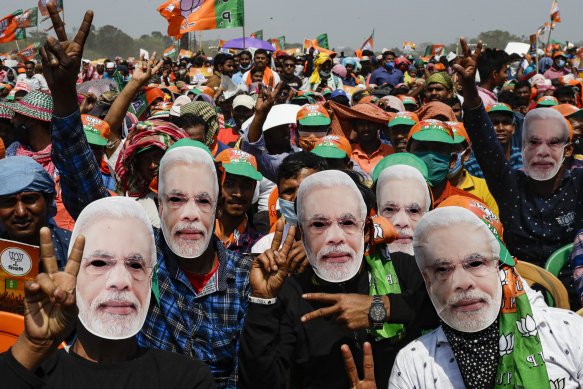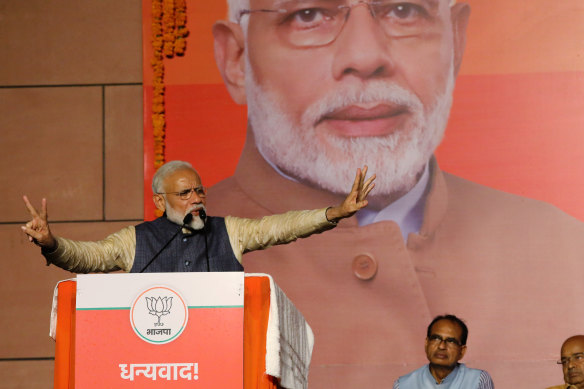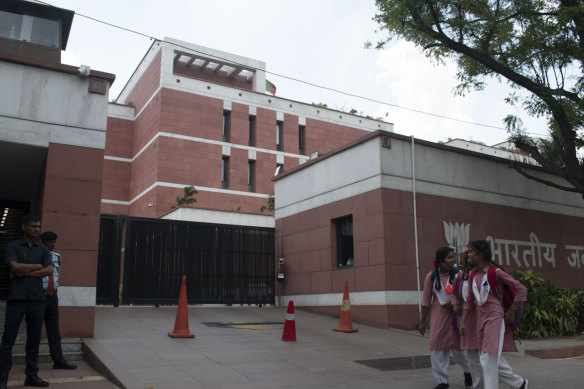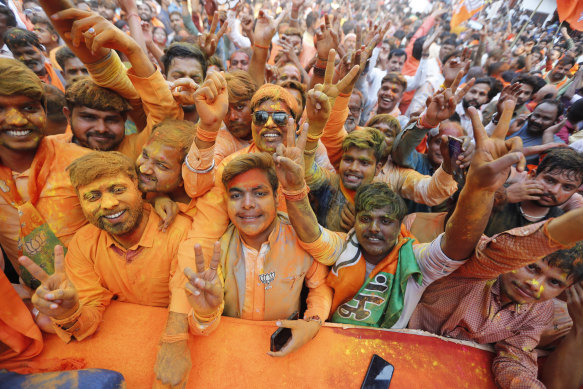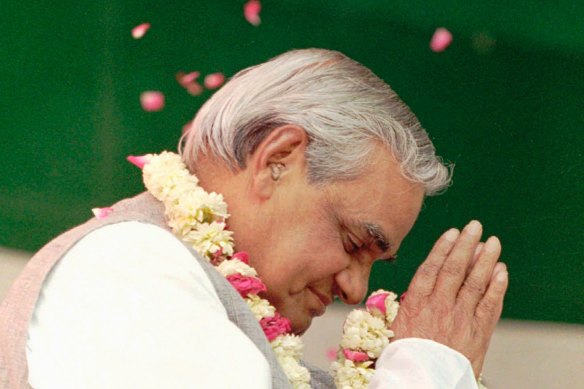BJP v CCP: The rise of the world’s biggest political party
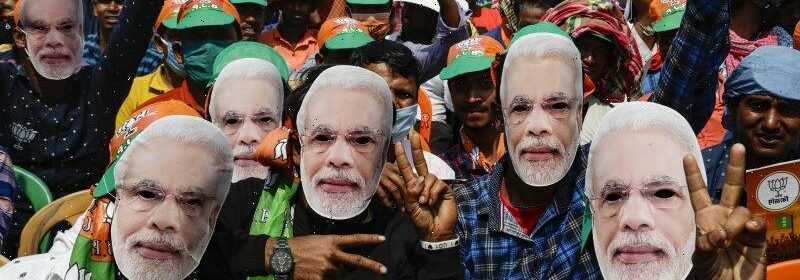
Not far from Connaught Place, the frenetic hub of India’s capital Delhi, is the headquarters of the world’s biggest political machine: the Bharatiya Janata Party, or BJP.
The party boasts more than 170 million members after a five-fold increase in the past eight years. Only a handful of nations have a bigger population than that. Membership of the famed Chinese Communist Party – around 96 million – pales by comparison.
Bharatiya Janata Party (BJP) supporters wear masks of Prime Minister Narendra Modi.Credit:AP
The BJP’s imposing pink granite HQ in downtown Delhi is emblematic of its political success. The vast complex, opened in 2018, has the feel of a corporate nerve-centre with high security offices, an eatery and spacious custom-built media facilities. Chauffeur-driven VIPs in SUVs come and go accompanied by heavily armed police.
The BJP swept to power with a majority in India’s national parliament in 2014 and increased its share of seats at the last general election in 2019. The party also governs a swag of Indian states, either outright or in coalition with other parties. It has been especially successful in north India’s densely populated Hindi-speaking belt.
The BJP’s charismatic leader, Prime Minister Narendra Modi, has emerged as the most dominant Indian politician in generations and is playing an increasingly influential role on the global stage.
Suresh Kumar Sharma, an auto rickshaw driver who lives in Delhi’s outer suburbs, is typical of Modi’s political fan-base.
“He fights corruption and fights the terrorists,” he says. “And Modi is always helpful to poor people.”
Narendra Modi, India’s Prime Minister, speaks during an event at BJP headquarters in Delhi in 2019. Credit:Bloomberg
But the BJP’s rise has been controversial. A key reason for the party’s success is its unapologetic appeal to Hindu nationalism and “Hindutva”, a philosophy that Hinduism and Indian national identity are more or less synonymous. The BJP has been accused of intolerance and sectarianism towards religious minorities, especially India’s Muslim community which comprises about 14 per cent of the population.
The BJP’s ascendancy coincides with rapidly improving ties between India and Australia. The rejuvenated Quadrilateral Security Dialogue, or Quad, involving India, Australia Japan and US, has become a key pillar in Australia’s foreign policy. Earlier this year India and Australia signed a landmark trade agreement which promises to boost trade.
And yet, the BJP is not well known in Australia, especially in comparison with the Chinese Communist Party. So how did the BJP become such a political hit?
The BJP’s imposing HQ in downtown Delhi is a sign of its success.Credit:Matt Wade
Modi’s popularity and the BJP’s aggressive pro-Hindu politics have been crucial electoral assets. But political scientist and journalist Nalin Mehta argues in his new book The New BJP that the party’s electoral success goes much deeper.
The BJP was once seen as a party for city-based upper-caste voters but has now managed to broaden its appeal to lower-caste and other social groups at the village level.
“The BJP has become the most socially representative party in north India, bar Muslims,” says Mehta. “The BJP’s election wins have also notably been in seats reserved for Dalits (formerly known as untouchables) and tribal (or indigenous) populations. Through a strategy of mergers and acquisitions, the BJP has further expanded politically into newer catchment areas geographically like India’s north-east, where Christian voters are significant and, in some states, constitute the majority.”
To achieve this the BJP enlisted party officials and local candidates from a range of social backgrounds, including women. It has also used welfare programs, focused on housing, sanitation and domestic gas supply, to create a new voting class of beneficiaries called “labharthis” and to target women voters.
“They have really changed the playing field and that is one reason more women, particularly in rural areas, are voting for them,” says Mehta.
Dr Vinay Sahasrabuddhe, a former national vice-president of the BJP, claims all members have the opportunity to rise through the party ranks.
“BJP comes across as a party of dedicated and credible leaders and perhaps the only party that talks of politics of performance through good governance and development,” he says.
“In BJP any of our volunteers can reach at the highest position in the party, unlike most other parties. Besides, BJP is a nation-first party with nationalism as its core value. Naturally, joining BJP becomes a hugely attractive proposition.”
Sahasrabuddhe, who has been personally involved in BJP membership drives, says a hallmark of the party is that members are “active, not just limited to tokenism”.
India has undergone a digital revolution during the past decade, facilitated by very cheap mobile phone data. The BJP has skilfully harnessed this tool to recruit new party members, monitor party operations, mobilise voter support and attack political opponents.
Mehta argues the BJP’s sophisticated use of digital technology, especially social media, is “at the heart” of what helped turn it into the world’s biggest political party.
“Leveraging digital technology gave party leaders the ability to organise a large-scale campaign and verify the expansion in a way that was simply not feasible earlier,” he writes.
Sydney University political sociologist Salvatore Babones, who researches Indian democracy, says the BJP has been able to combine deep cultural connections to the Indian community with contemporary scientific political strategies.
“It is successful because it is, at the same time, organic and modern,” he says.
The surge in BJP membership was the outcome of two massive membership drives in 2014 and 2019. The second was combined with a village-level campaign to plant trees.
Bharatiya Janata Party (BJP) workers celebrate in Lucknow, India, ahead of election results in March 2022Credit:AP
There are claims the BJP’s membership data is exaggerated, but Mehta points out that even if one-third of the party’s members are transient, the party “would still be larger than the Chinese Communist Party by 20 per cent”.
The BJP has achieved its impressive membership despite a plethora of alternative political parties – India is the world’s largest democracy, with more than 900 million registered voters at the last general election.
“The big difference between CCP and BJP is that the Chinese party’s cadres are enlisted within a one-party state – they don’t have the option of joining any rival party,” says Mehta. “BJP’s expansion in India, on the other hand, is within a multi-party democratic system. This is why BJP’s cadre expansion on this scale, within an India where several states are not in its control and where it can often also suffer electoral reverses – like it did most recently in West Bengal and in Punjab – is staggering.”
Enthusiasm for the BJP extends well beyond the borders of India. Melbourne IT consultant Jay Shah is president of the Overseas Friends of BJP Australia, part of an international network which “supports and sympathises” with the party.
“We are all volunteers,” he says. “We are doing this as a passion.”
Shah even travelled to India before the past two general elections, in 2014 and 2019, to help campaign for the BJP.
“There are so many like me who went and campaigned for the party,” he says, “I didn’t go to the big cities but to the villages … it was an eye-opening experience.”
Atal Bihari Vajpayee was the party’s first prime minister.Credit:AP
The BJP was founded in 1980 and gained electoral strength during the 1990s. The party’s first prime minister, Atal Bihari Vajpayee, led a series of coalition governments between 1996 and 2004. With Modi’s electoral triumph in 2014 the BJP became the first party to win a national parliamentary majority in 30 years.
The Modi government has introduced several significant economic changes including a Goods and Services Tax (GST), which simplified India’s fragmented network of indirect taxes, although some have been disappointed at the slow pace of major reforms. Amid vexed relations with China, Modi has sought to deepen relations with the US and other Indo-Pacific nations, including Australia.
But international indicators show the health of Indian democracy has been declining since the BJP took office in 2014.
The 2022 “Freedom in the world” report by American government-funded think tank Freedom House claims freedom in India has declined over the past decade.
“While India is a multi-party democracy, the government led by Prime Minister Narendra Modi and his Hindu nationalist Bharatiya Janata Party has presided over discriminatory policies and a rise in persecution affecting the Muslim population,” it says.
India has more than 100,000 newspapers (including 36,000 weeklies) and over 350 TV news channels but the latest World Press Freedom Index, prepared by media watchdog Reporters Without Borders, found India’s press freedom ranking fell in 2022. The report cited widespread violence against journalists, growing media partisanship and concentration of media ownership as reasons for the decline.
India’s Information and Broadcasting Minister Anurag Thakur rejected the report’s findings, saying the methodology was “questionable and non-transparent”. He said the government was committed to ensuring the right to freedom of speech and expression enshrined in India’s constitution.
Even so, the Economist Intelligence Unit’s annual Democracy Index shows India’s ranking has waned markedly since peaking in 2014, the year the BJP won office.
The unit’s latest report says there has been “a serious deterioration in the quality of democracy under leader Narendra Modi, whose Hindu-nationalist Bharatiya Janata Party has presided over increased intolerance and sectarianism towards Muslims and other religious minorities” and that a failure to “crack down on the persecution of religious and other minorities by Hindu nationalists continues to weigh on India’s democracy score”.
To rise from the fringes of Indian politics to become the world’s biggest party has been a stunning achievement. But can Indian democracy flourish with a political behemoth like the BJP?
Matt Wade visited India and attended the Australia India Leadership Dialogue as the guest of the Australia India Institute.
The Morning Edition newsletter is our guide to the day’s most important and interesting stories, analysis and insights. Sign up here.
Most Viewed in World
From our partners
Source: Read Full Article
